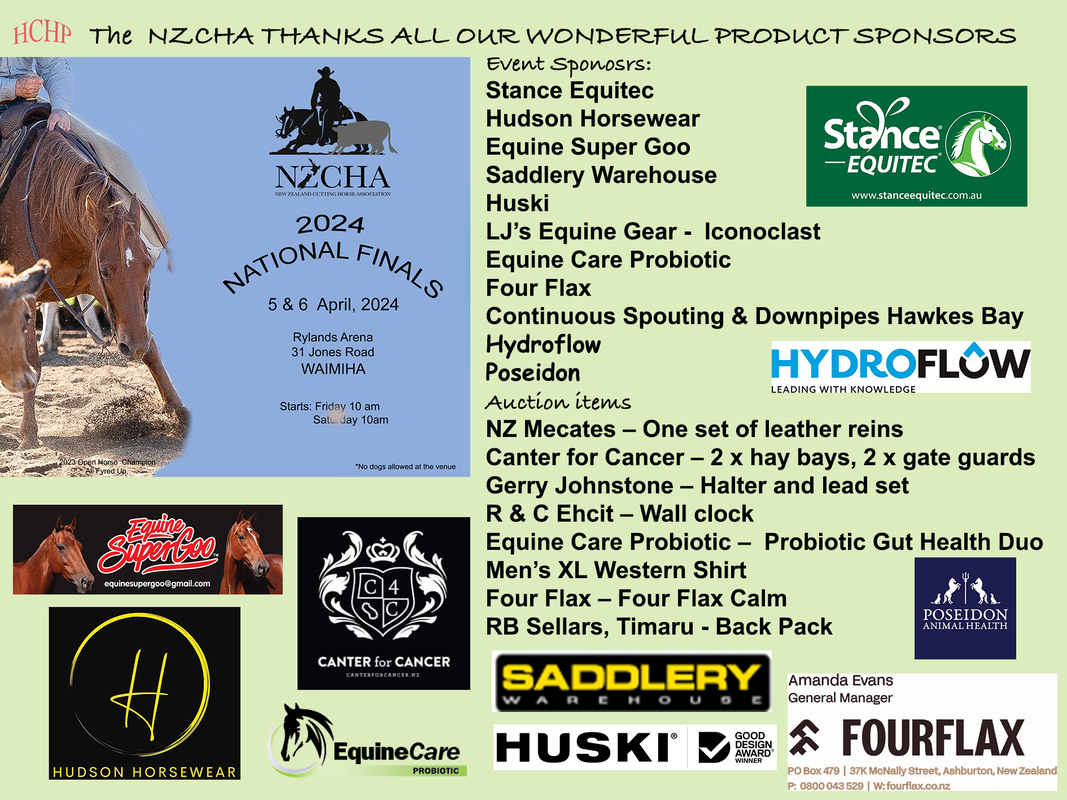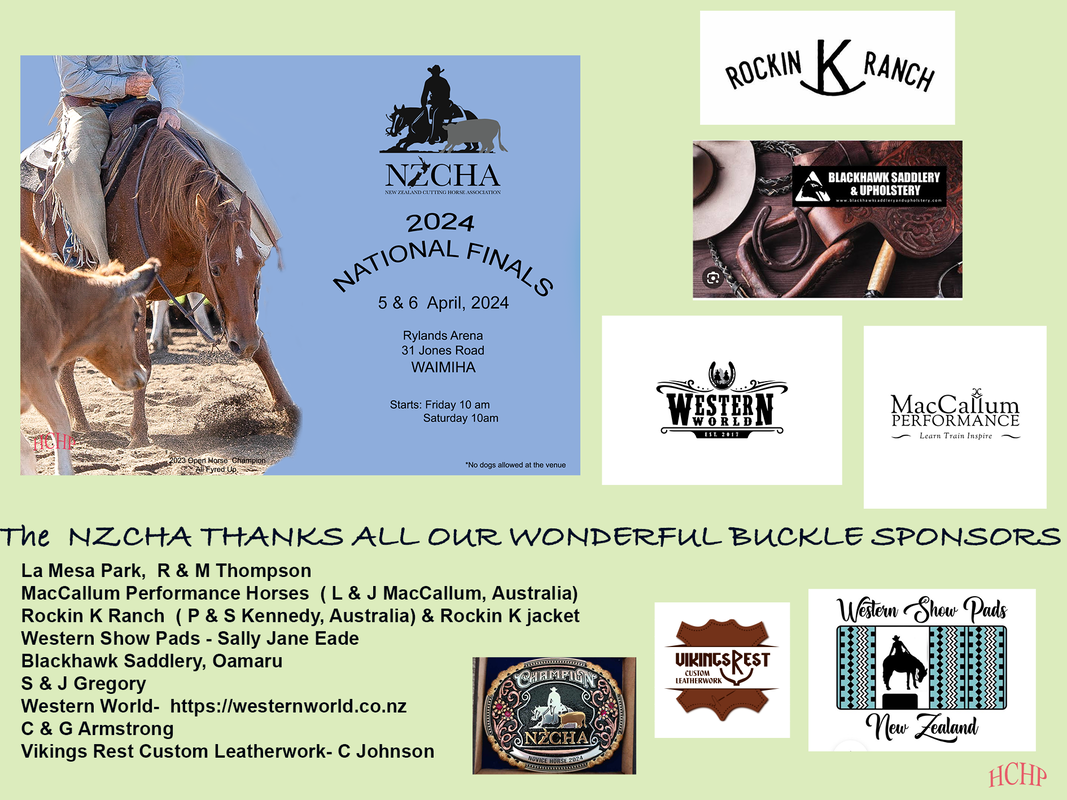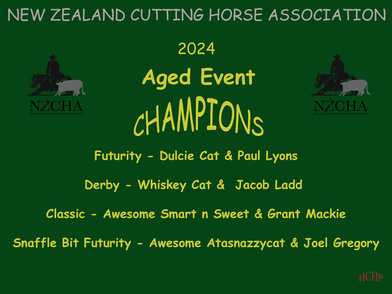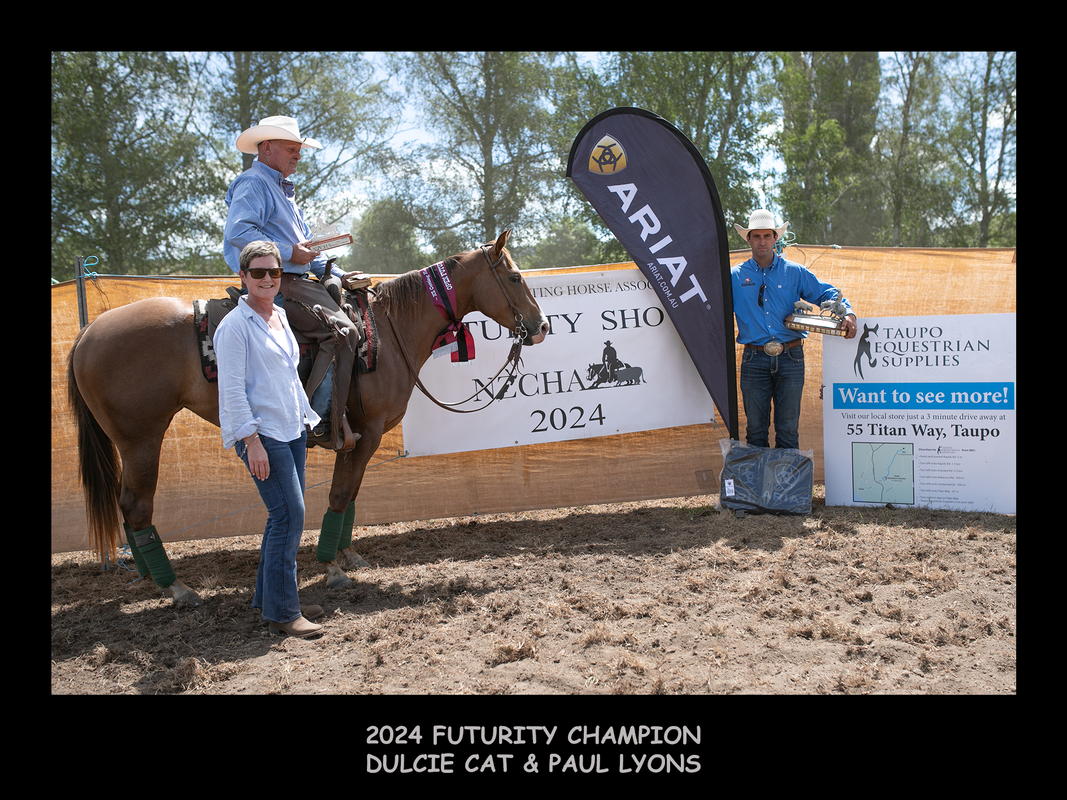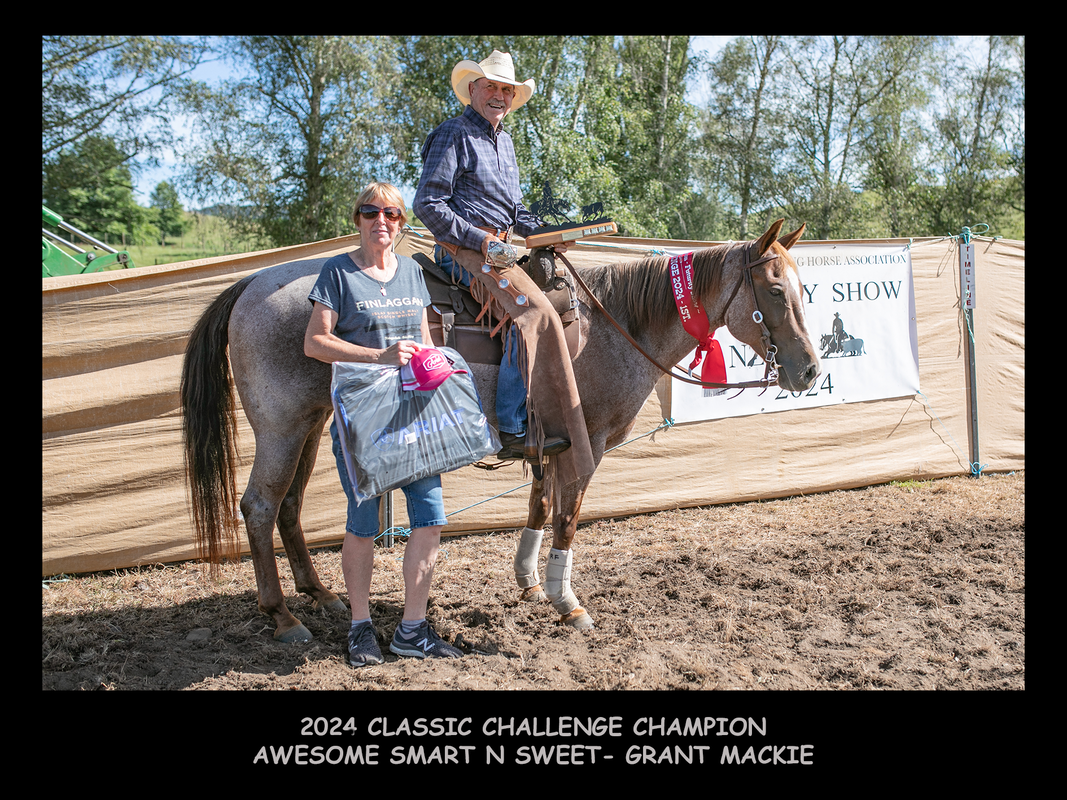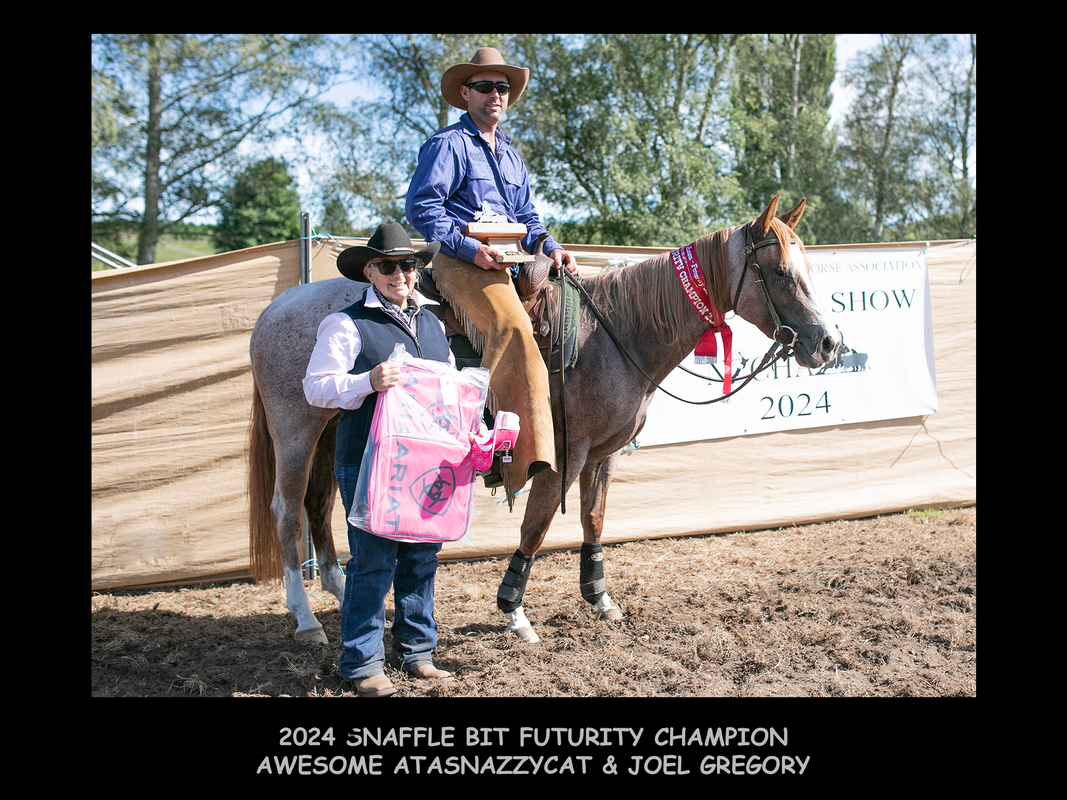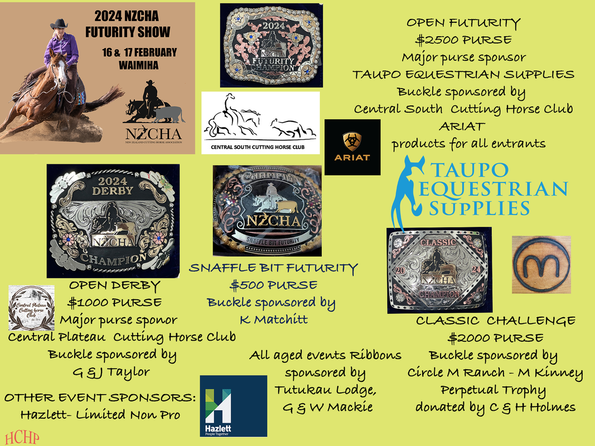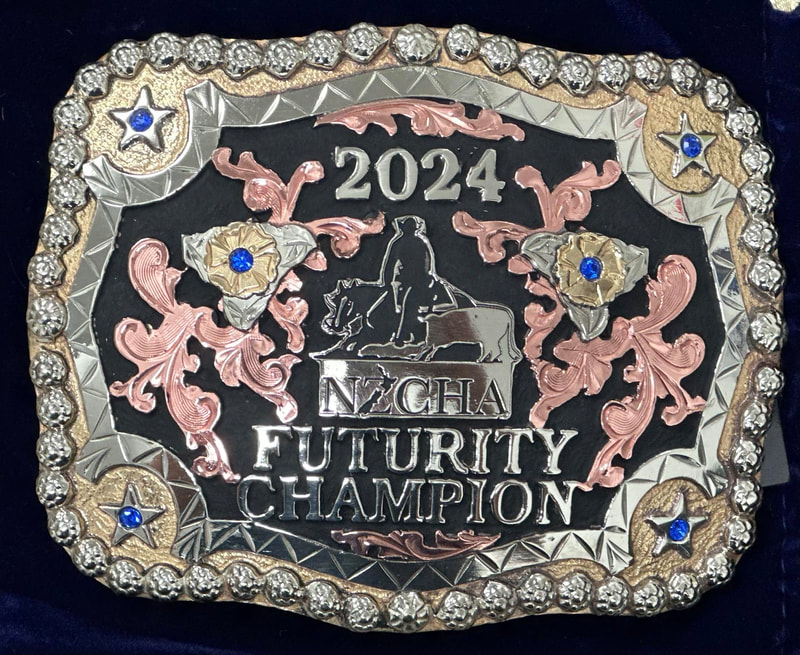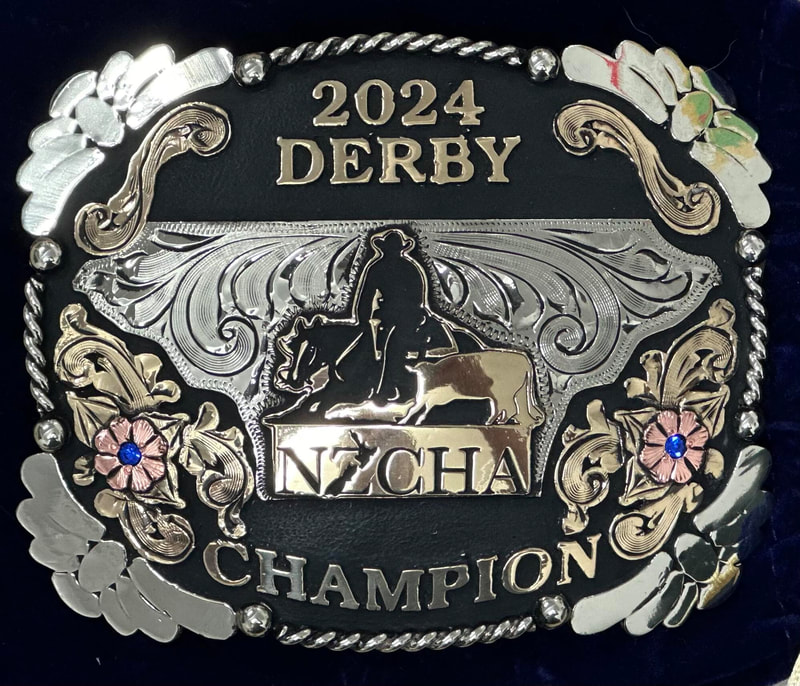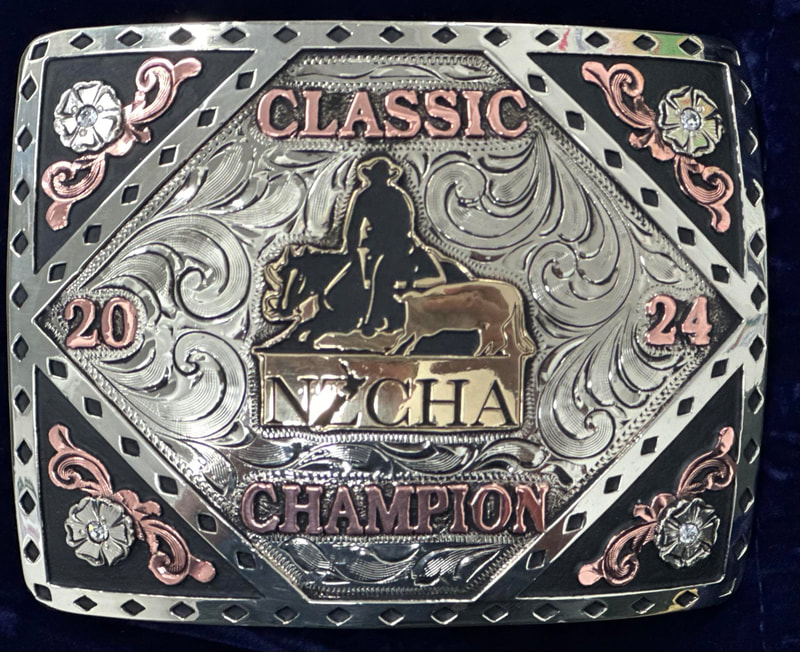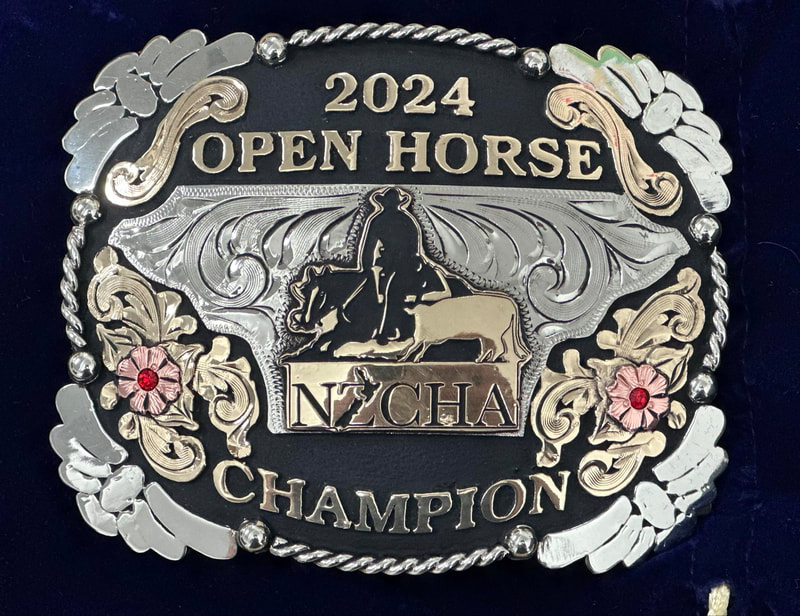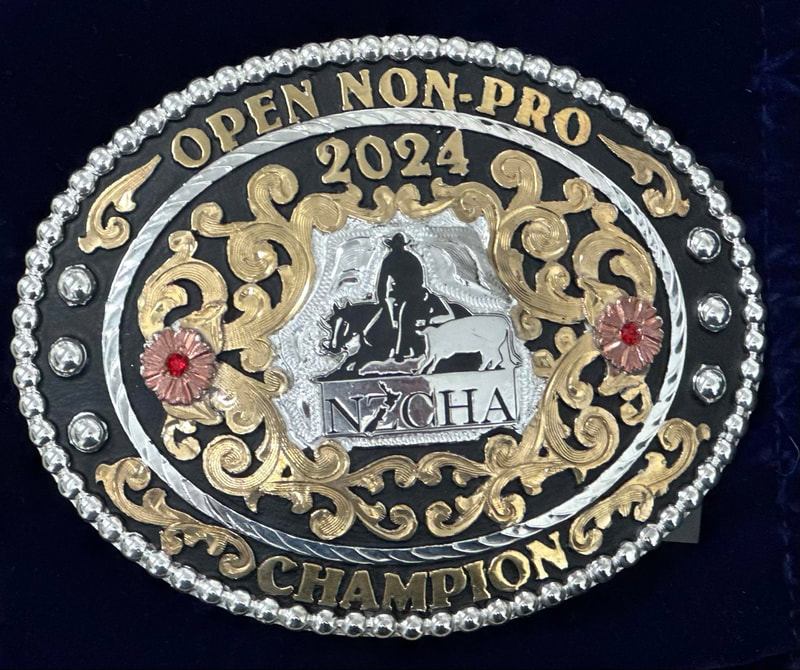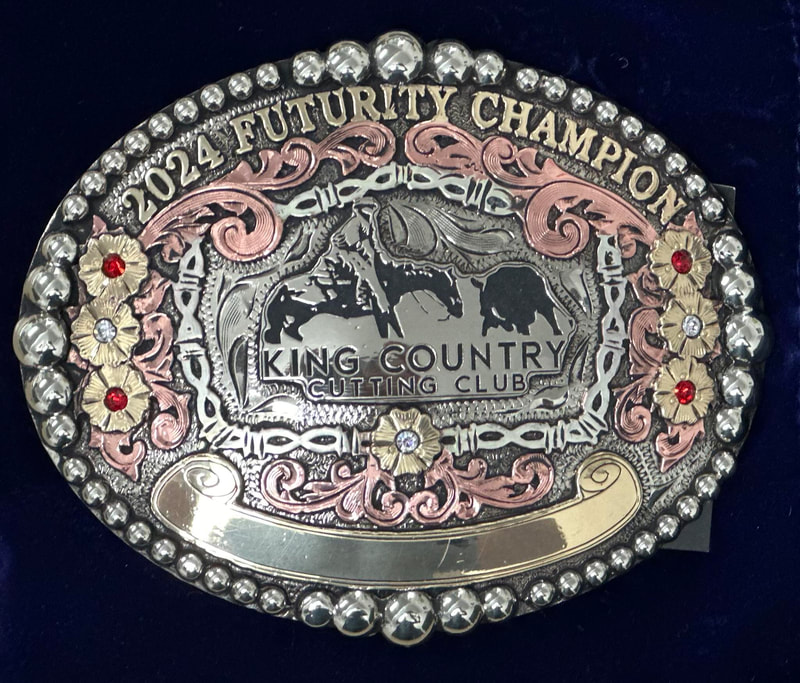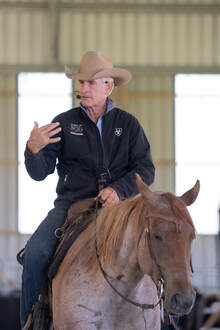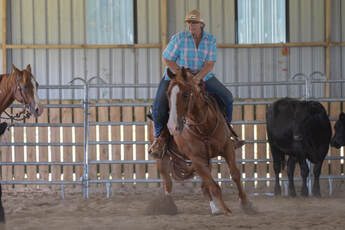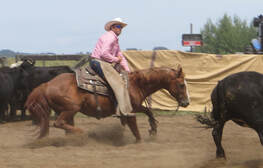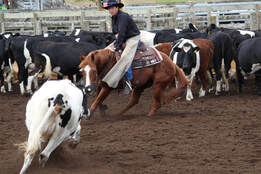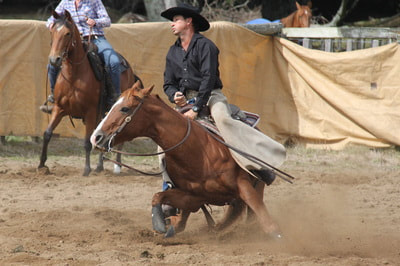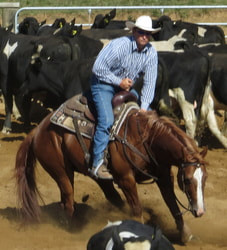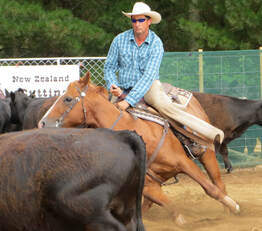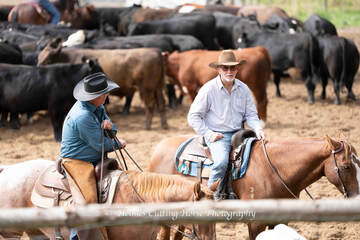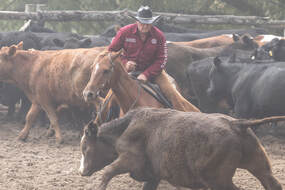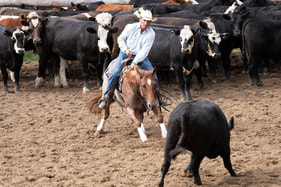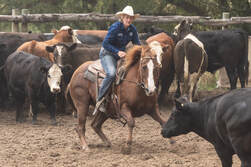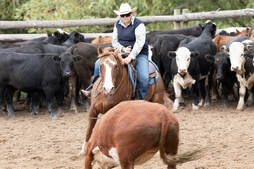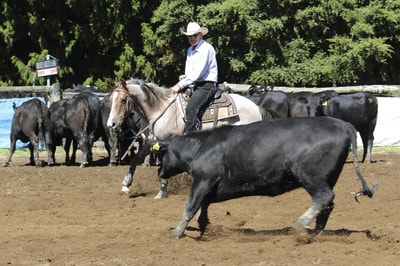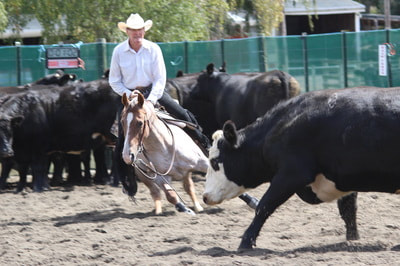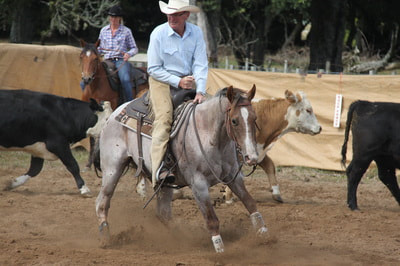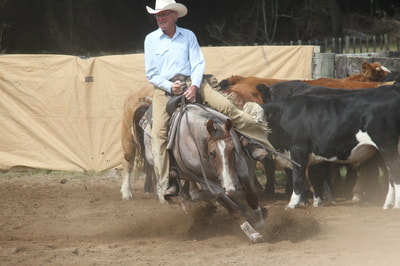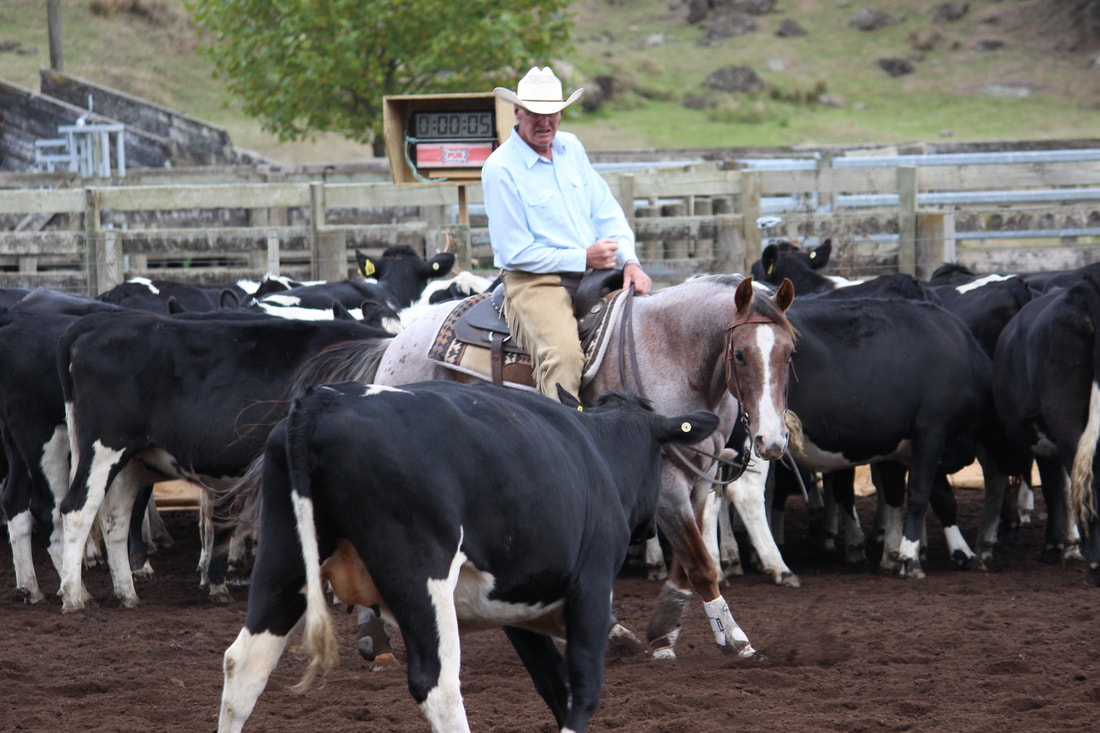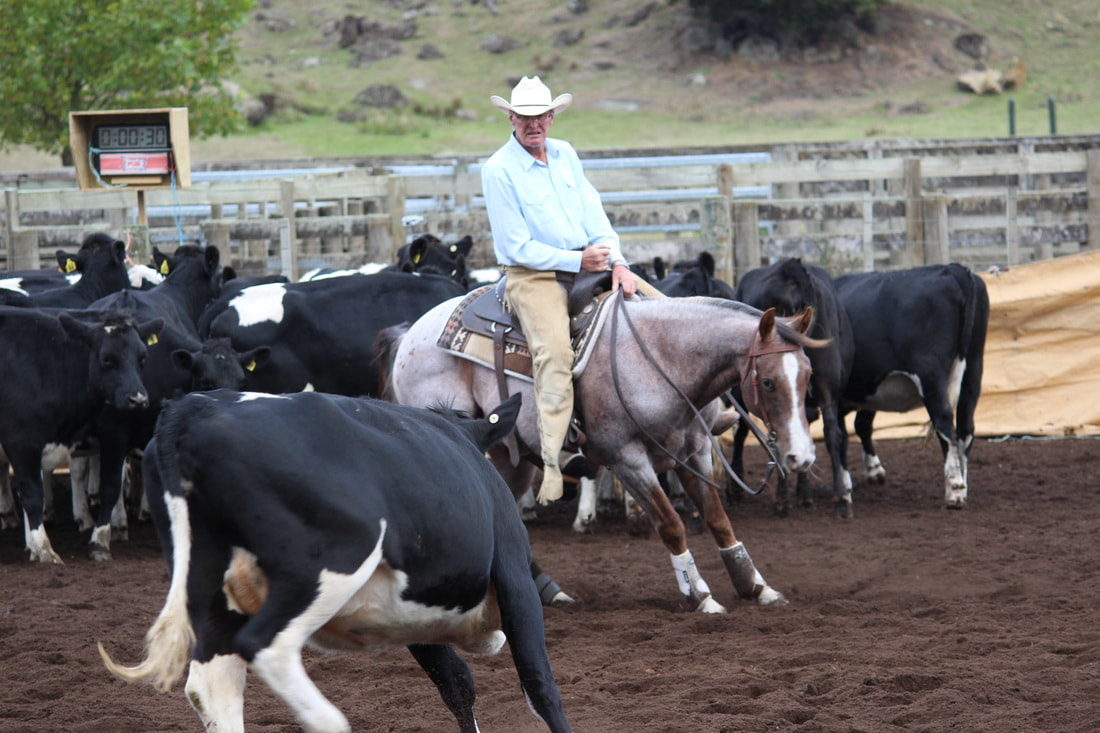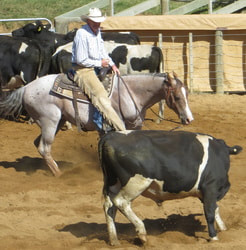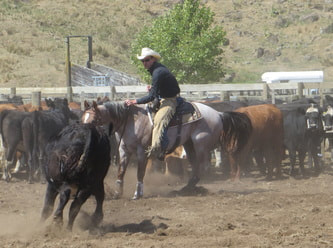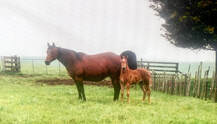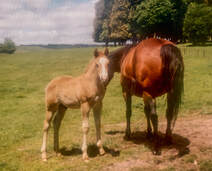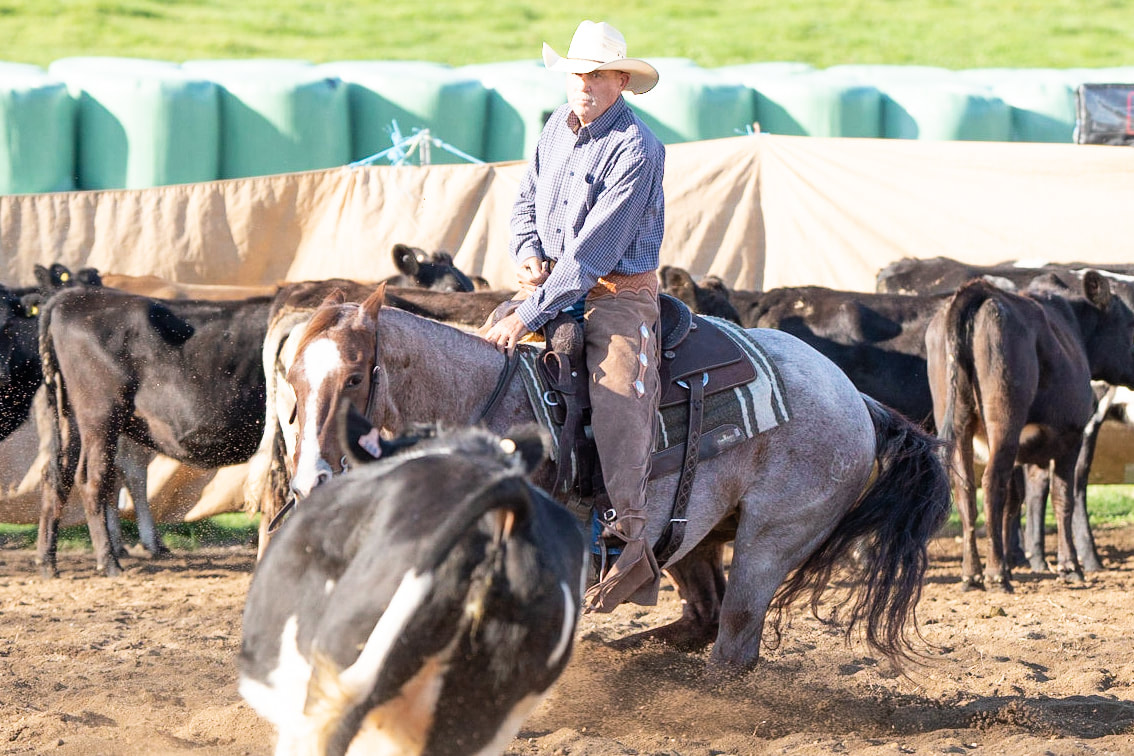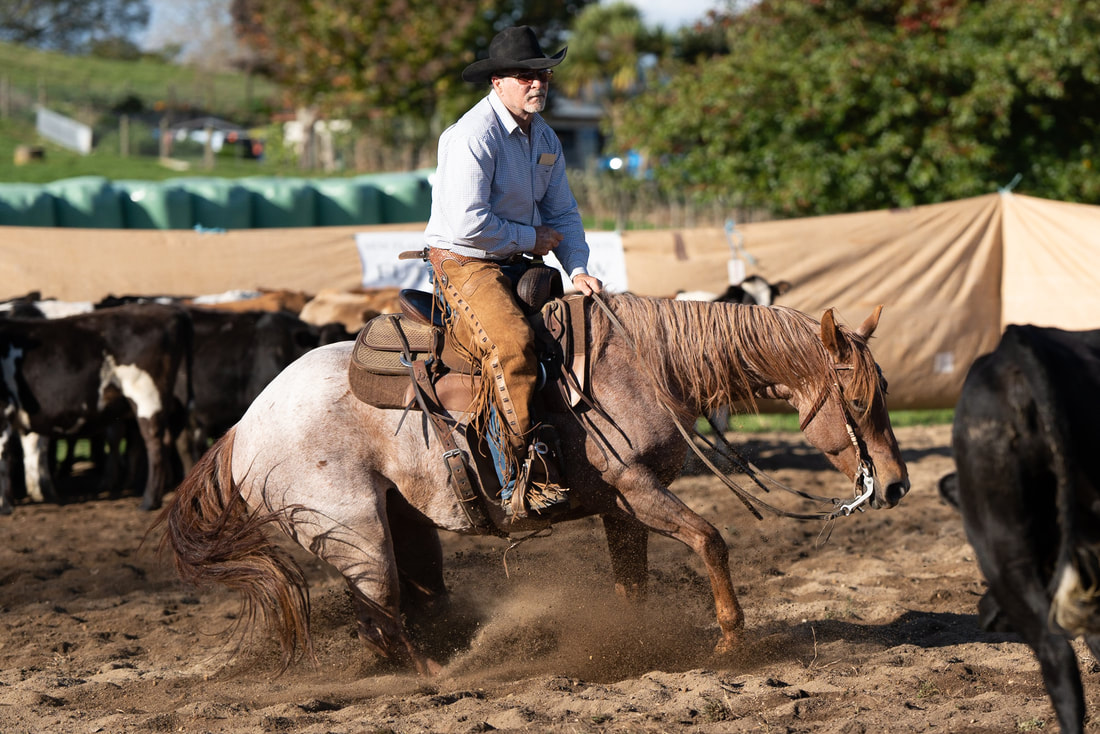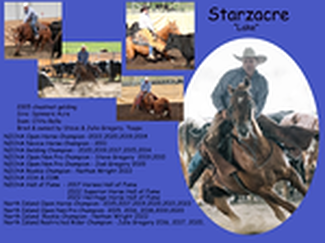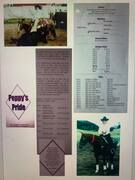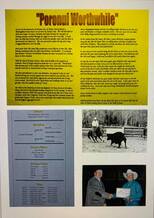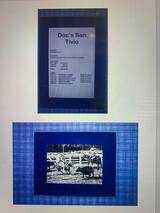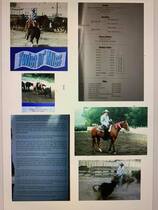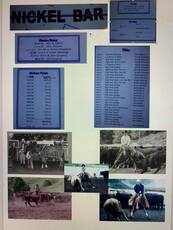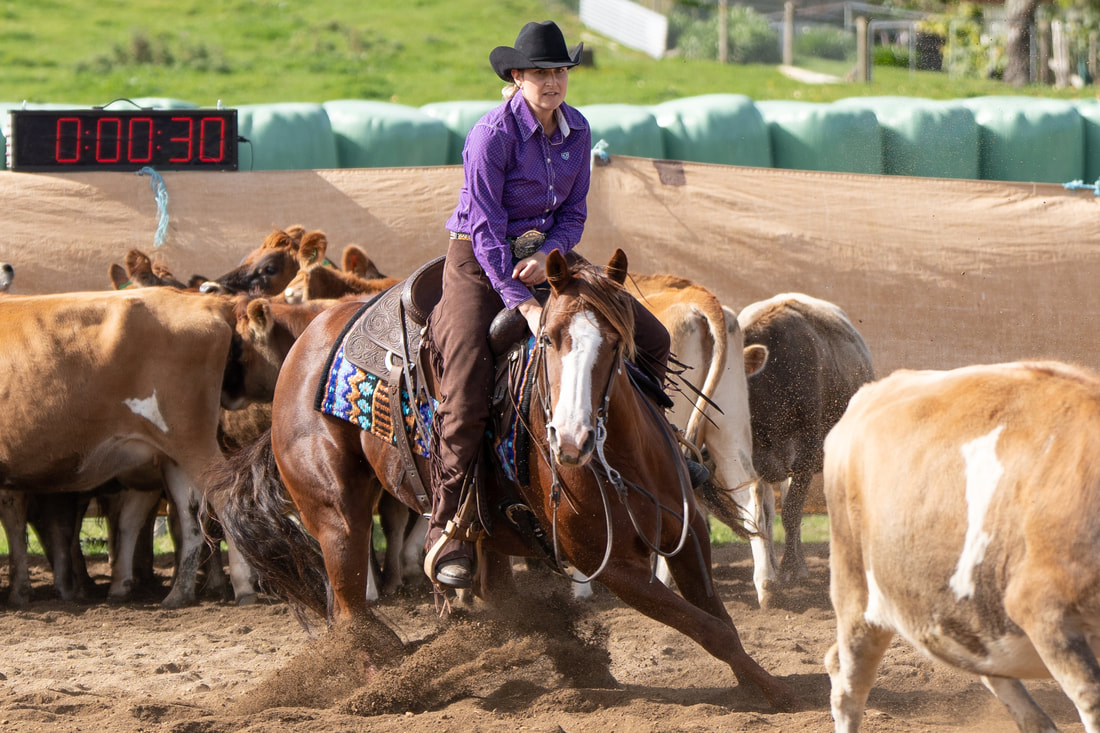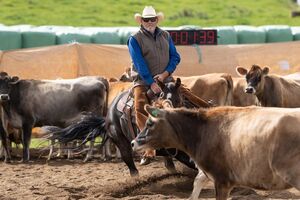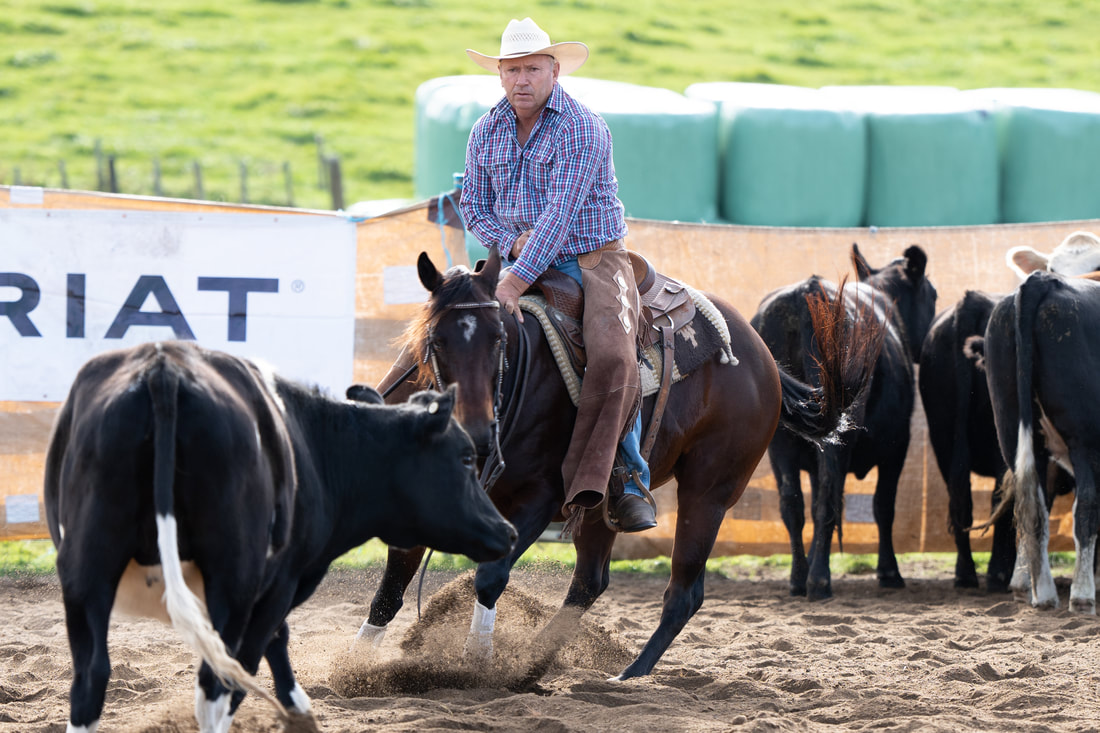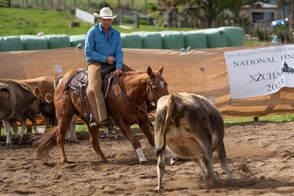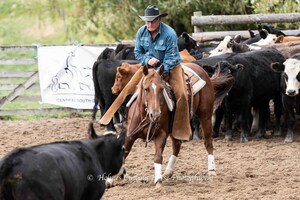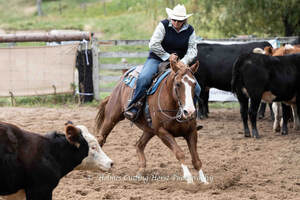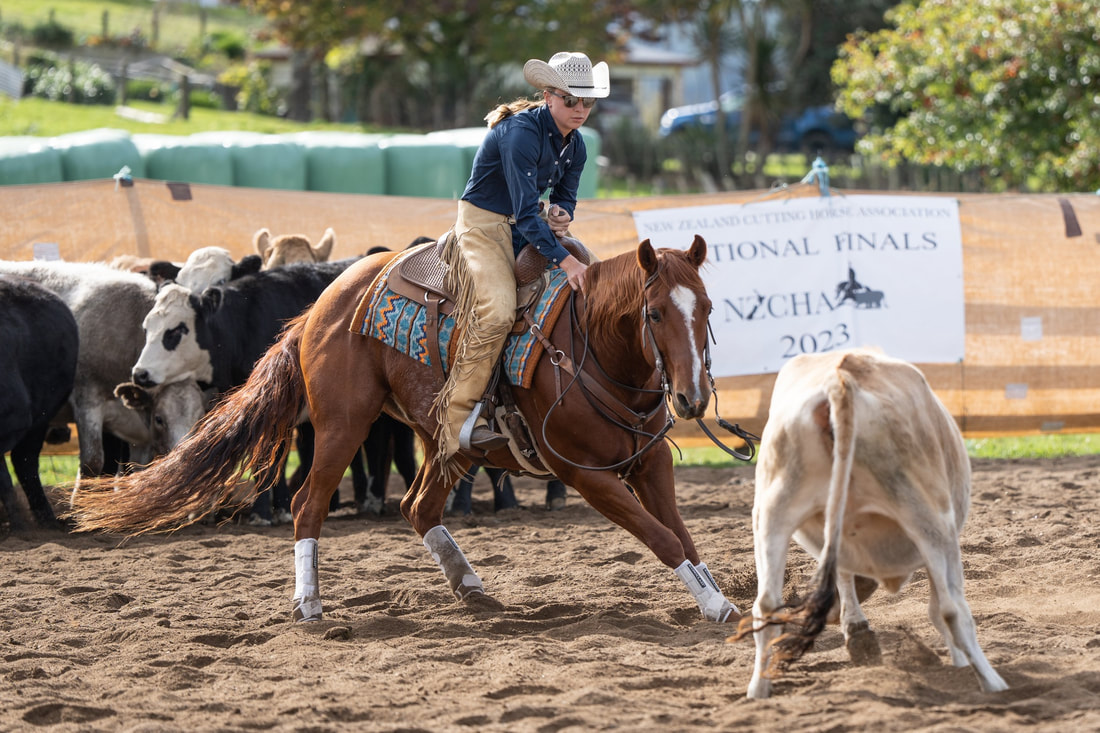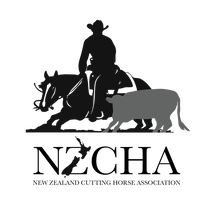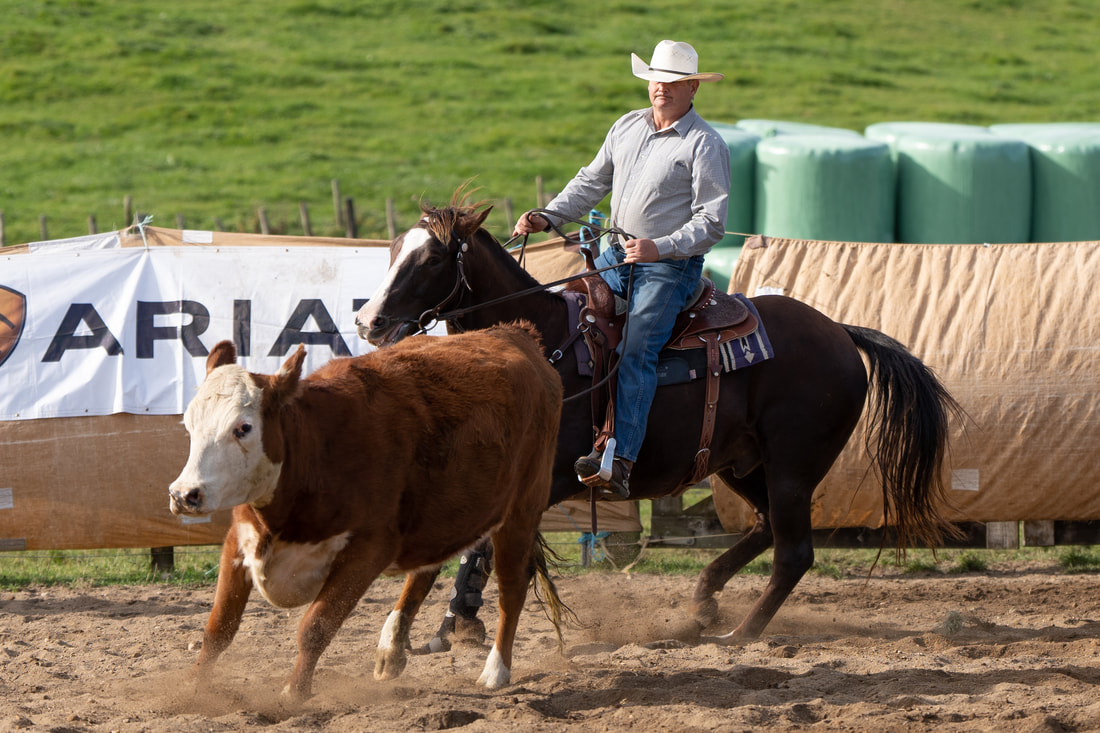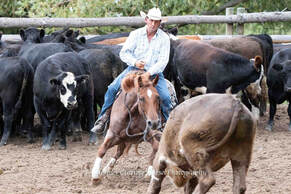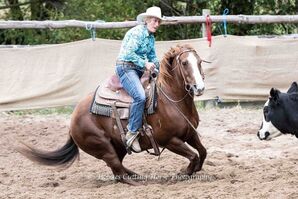2024 judges card update
Information regarding the new 2024 judges cards can be found on the Judges page. An explanation video from Andy Adams, Director of Judges NCHA, has also been uploaded.
2024 NZCHA CHAMPIONS
2024 Open Horse Champion - All Fyred Up ridden by Colin Holmes
Thank you to our sponsors
Buckle sponsored by La Mesa Park (R & M Thompson)
Purse sponsored by Bybs & Justine Gibson
Thank you to our sponsors
Buckle sponsored by La Mesa Park (R & M Thompson)
Purse sponsored by Bybs & Justine Gibson
2024 Novice Horse Champion - Dulcie Cat ridden by James Hazeldine & owned by Paul Lyons
Thank you to our sponsors
Buckle sponsored by MacCallum Performance (Lynda and Jim MacCallum)
Purse sponsored by Continuous Spouting Hawkes Bay Ltd
Thank you to our sponsors
Buckle sponsored by MacCallum Performance (Lynda and Jim MacCallum)
Purse sponsored by Continuous Spouting Hawkes Bay Ltd
2024 Open Non Pro Champion - Jacob Ladd & Whiskey Catt
Thank you to our sponsors
Buckle sponsored by Rockin K Ranch (Pete & Sarah Kennedy) and Jacket for the winner
Purse sponsored by Melissa & Wayne Poingdestre & Catherine Ladd Performance Horses
Thank you to our sponsors
Buckle sponsored by Rockin K Ranch (Pete & Sarah Kennedy) and Jacket for the winner
Purse sponsored by Melissa & Wayne Poingdestre & Catherine Ladd Performance Horses
2024 Limited Non Pro Champion - Peter Ormiston & Henry's Choice
Thank you to our sponsors
Buckle sponsored by Western Show Pads New Zealand (Sally Jane Eade)
Purse sponsored by Island Stream QH’s (H & M Morrissey)
Thank you to our sponsors
Buckle sponsored by Western Show Pads New Zealand (Sally Jane Eade)
Purse sponsored by Island Stream QH’s (H & M Morrissey)
2024 U1500 Non Pro Champion - Anna Dawson & Iscotaspin
Thank you to our sponsors
Buckle sponsored by Blackhawk Saddlery
Purse sponsored by NW Plumbing Ltd (N & A Wright)
Thank you to our sponsors
Buckle sponsored by Blackhawk Saddlery
Purse sponsored by NW Plumbing Ltd (N & A Wright)
2024 Restricted Rider Champion - Nathan Wright & Lace
Thank you to our sponsors
Buckle sponsored by – S & J Gregory
Purse sponsored by – S & J Gregory
Thank you to our sponsors
Buckle sponsored by – S & J Gregory
Purse sponsored by – S & J Gregory
2024 Rookie Rider Champion - Nathan Wright & Starzacre
Thank you to our sponsor Vikings Rest Custom Leatherwork
Thank you to our sponsor Vikings Rest Custom Leatherwork
2024 Youth Rider Champion - Chloe Gregory & Starzacre
2024 Snaffle Bit Rider Champion - Alana Rowe & Cat Merada
Thank you to our sponsors
Buckle sponsored by – C & G Armstrong
Purse sponsored by – Warakihi Equine NZ (Mindy Matchitt)
Thank you to our sponsors
Buckle sponsored by – C & G Armstrong
Purse sponsored by – Warakihi Equine NZ (Mindy Matchitt)
2024 Snaffle Bit Horse Champion - Awesome SmartNSweet ridden by Grant Mackie
Thank you to our sponsors
Buckle sponsored by – Western World
Purse sponsored by – Continuous Spouting Hawkes Bay Ltd
Thank you to our sponsors
Buckle sponsored by – Western World
Purse sponsored by – Continuous Spouting Hawkes Bay Ltd
|
CONTENTS UP DATE WITHIN THE WEBSITE DATE PAGE/SUBPAGE - CONTENT UPDATE 20/7/24 2024 Rider LTE Updated 20/7/24 2024 Horse LTE updated 13/7/24 2024 Judges card educational series - see Judges page 23/4/24 National & Island Champions updated 8/4/24 CONTACTS - New Council updated 31/3/24 EVENTS/RESULTS - North Island Finals results posted 30/3/24 LATEST NEWS - KCCC feature events champions 30/3/24 EVENTS/RESULTS - NATIONAL FINALS. - draws posted 25/3/24 EVENTS/RESULTS - South Island Finals & CSCHC Club results 25/3/24 EVENTS/RESULTS- 2024 NZCHA AGM new page with the AGM files 24/3/24 EVENTS/RESULTS- NATIONAL FINALS - NFs information added 24/3/24 LATEST NEWS - current standings 22/3/24 SPONSORS - Update of sponsors 7/3/24 HALL OF FAME/ HORSE STORIES - A new page telling the stories of all the horses inducted into the Hall of Fame and Heritage Hall of Fame has been constructed. All is done except for more photos to find and add. 26/2/24 EVENTS/RESULTS- Mackies & Futurity show results posted EVENTS/RESULTS - FUTURITY - show results posted 25/2/24 FUTURITY SHOW HISTORY FROM 1981 -new page started 19/2/24 EVENTS/RESULTS - Aged events champions announced 14/2/24 EVENTS/RESULTS - FUTURITY - information &. draws posted 5/2/24 EVENTS/RESULTS - CPCHC ladds show results posted 5/2/24 EVENTS/RESULTS - KCCC postponement 23/1/24 CHATTER - January Chatter posted. EVENTS/RESULTS- CPCHC McInnes show results posted. LATEST NEWS - National Final buckles/sponsors photos posted. 13/1/24 SPONSORS- page is fully updated with all our amazing 2024 sponsors LATEST NEWS - a big thank you to our 2024 sponsors FORMS - forms and info for the 2024 AGM |
REMINDERS CHECK OUT THE NEW SUB PAGE
1/5/24 EVENTS/RESULTS- 2024 NZCHA AGM The new page with the AGM files 2024 AGM minutes Audited Financial Accounts |
LATEST NEWS
2024 Season Earnings
|
Open Horse
Starzacre 1319.1 Isle B Playin 700.8 Duracks Rey of Lite 598 Lace 521.75 Rory 417.8 All Fyred Up 412.75 Alittlesophisticated 94.2 Awesome SmartNSweet 82.8 Henrys Choice 68 Whiskey Catt 34 I Scotaspin 33.3 Novice Horse Alittlesophisticated 699.6 Isle B Playin 641.6 AwesomeSmartNSweet 472 Whiskey Catt 402.9 Reys A Sannman 356.2 Dulcie Cat 225 That's A Cat 193.6 I Scotaspin 185.1 Potty Catt 64 Open Non Pro Steve Gregory 853.5 Wayne Poingdestre 636.9 Mindy Matchitt 578.3 Barry Ladd 429.4 Jacob Ladd 319.6 Geoff Taylor 307 Colin Holmes 136.5 Julie Gregory 118.8 Joel Gregory 48 Limited Non Pro Peter Ormiston 276.8 Melissa Poingdestre 224.4 Anna Dawson 188.5 Paul Lyons 78 Catherine Ladd 51.6 |
U1500 Non Pro
Karen Matchitt 445.4 Anna Dawson 438.1 Merrill Kinney 242.3 Paul Lyons 58.2 Lynda Ormiston 28 Rookie Nathan Wright 463.6 Restricted Nathan Wright 508.8 Merrill Kinney 140.35 Julie Gregory 106.5 Lynda Ormiston 72 Snaffle Bit Rider Alana Rowe 478.7 Frank Grieve 297.2 Dominika Tupa 60.8 Jess Bielski 59 Cookie Clark 23.8 Snaffle Bit Horse Cat Merada 393.2 AwesomeSmartNSweet 355.2 Little Royal Spin 220.6 Brave 46.2 Ace 35.7 |
Thankyou to all these amazing sponsors of our NATIONAL FINALS
|
10/1/24 NZCHA ROBERT MACKAY CLINIC REPORT
On the 6th & 7th January Robert Mackay from Australia ran a cutting clinic for the NZCHA. It is pretty much summed up in these comments from attendees. “Thanks for a great clinic, excellent trainer and awesome facility , learnt heaps " “Thank you NZCHA for putting this clinic together, it's so good to be able to have these top trainers come over and share their expertise with us. A huge thank you to Robert for giving up his time to come over for us. Thoroughly enjoyed the weekend!”“Fantastic clinic from a great horseman and trainer with a wealth of experience. We are very blessed to get these professionals out to NZ with their busy schedules.” “A fabulous opportunity for those who were on the clinic to learn from Robert, a true legend of cutting in Australia. Robert has so much knowledge and expertise and Robert was very good at communicating that to us all. We all learnt heaps it was just awesome.” “Special thanks also to Helen and Colin Holmes for hosting the clinic and providing such a wonderful property and facility.” They would like to thank Kristin, Lizzie, Molly and Eilidh for all their help before and during the clinic and the KCCC. Thank you to Lori for sharing your knowledge of cutting worldwide, your family’s immense contribution for introducing cutting into Australia and your willingness to help the NZCHA in any way you could be it the Hall of Fame, Youth etc. Thank you Robert for coming to NZ. We hope you and Lori enjoy your holiday time in the South Island before the South Island Clinic, 13th & 14th January at Geoff & Janine Taylors property in Kakanui. |
IMPORTANT RULE CHANGES AS PER THE 2023 RULE BOOK AMENDMENTS - Please review the full amendments document and. 2023 Rule book for all changes - visit Rule Book in the menu
SECTION: YOUTH DIVISION, PAGE 39- RULE 9 and SECTION: CONTEST ARENA REGULATIONS, PAGE 16, NEW RULE .9
11. Helmets are mandatory for all Youth Competitors or Children (all those under 18 years of age) when they are riding a horse both inside or outside the arena at any NZCHA affiliated event.
SECTION: CONTEST ARENA REGULATIONS, PAGE 16, NEW RULE .9
9. There should not be children in the arena while a show is running unless they are in the arena for the purpose of being involved in the cutting competition.While in the arena, they must be under adult supervision at all times.
SECTION NZCHA EVENTS, PAGE 10, RULE H- SNAFFLE BIT RIDER RULING
h. SNAFFLE BIT (RIDER)- The Snaffle Bit Rider is a one- or two-handed contest, open to ALL riders regardless of LTE. There is a limit of two horses per rider in this class, and only the points from their highest earning horse will count towards high point awards. Horse/rider combinations may only enter a maximum of two Snaffle Bit classes per show.
Any rider who has competed in a hands down event in the current season is not eligible to ride in Snaffle Bit Rider. Once a rider competes in a hand down class at any point in the season, they are no longer eligible to ride in snaffle bit rider for the remainder of that season.
Points earned in Snaffle Bit Rider are stand alone and do not count towards any other event eligibility. Snaffle Bit classes are exempt from Non-Pro rules excluding Snaffle Bit Aged events.
A competitor may borrow a horse and may pay a day fee to compete, however day fee competitors are not eligible to compete at National Finals or be eligible for North or South Island Annual awards. Horses may be shown using one or two hands on the bridle reins. Twisted wire snaffles, gag snaffles or shank snaffles shall not be used. Snaffle bits are to be a minimum of 10mm (3/8”) and have a smooth single jointed mouthpiece. Bosals and hackamores may be used. They shall be of rope or braided rawhide and have no metal parts. All other dress/equipment as per Rule 16.
SECTION- APPROVED CONTESTS- RULE 6. PAGE 22.
6. If any charge is to be made other than entry fee, it must be stated as NZCHA Levy, cale hire, officefee or video fee and the fee should be separated from the entry fee. This fee is to be charged to allcontestants and stated on the affiliaon form for publicaon in the Chaer. In all cuteng horse contests approved by the NZCHA all levies collected by the Show Management as calculated from the levies table must be forwarded to the NZCHA. No deducon, other than as specified above, shall be made. Failure to comply will cause approval of the show to be withdrawn. ( THIS NEW RULE HAS REMOVED: The office fee may not exceed the entry fee)
SECTION: YOUTH DIVISION, PAGE 39- RULE 9 and SECTION: CONTEST ARENA REGULATIONS, PAGE 16, NEW RULE .9
11. Helmets are mandatory for all Youth Competitors or Children (all those under 18 years of age) when they are riding a horse both inside or outside the arena at any NZCHA affiliated event.
SECTION: CONTEST ARENA REGULATIONS, PAGE 16, NEW RULE .9
9. There should not be children in the arena while a show is running unless they are in the arena for the purpose of being involved in the cutting competition.While in the arena, they must be under adult supervision at all times.
SECTION NZCHA EVENTS, PAGE 10, RULE H- SNAFFLE BIT RIDER RULING
h. SNAFFLE BIT (RIDER)- The Snaffle Bit Rider is a one- or two-handed contest, open to ALL riders regardless of LTE. There is a limit of two horses per rider in this class, and only the points from their highest earning horse will count towards high point awards. Horse/rider combinations may only enter a maximum of two Snaffle Bit classes per show.
Any rider who has competed in a hands down event in the current season is not eligible to ride in Snaffle Bit Rider. Once a rider competes in a hand down class at any point in the season, they are no longer eligible to ride in snaffle bit rider for the remainder of that season.
Points earned in Snaffle Bit Rider are stand alone and do not count towards any other event eligibility. Snaffle Bit classes are exempt from Non-Pro rules excluding Snaffle Bit Aged events.
A competitor may borrow a horse and may pay a day fee to compete, however day fee competitors are not eligible to compete at National Finals or be eligible for North or South Island Annual awards. Horses may be shown using one or two hands on the bridle reins. Twisted wire snaffles, gag snaffles or shank snaffles shall not be used. Snaffle bits are to be a minimum of 10mm (3/8”) and have a smooth single jointed mouthpiece. Bosals and hackamores may be used. They shall be of rope or braided rawhide and have no metal parts. All other dress/equipment as per Rule 16.
SECTION- APPROVED CONTESTS- RULE 6. PAGE 22.
6. If any charge is to be made other than entry fee, it must be stated as NZCHA Levy, cale hire, officefee or video fee and the fee should be separated from the entry fee. This fee is to be charged to allcontestants and stated on the affiliaon form for publicaon in the Chaer. In all cuteng horse contests approved by the NZCHA all levies collected by the Show Management as calculated from the levies table must be forwarded to the NZCHA. No deducon, other than as specified above, shall be made. Failure to comply will cause approval of the show to be withdrawn. ( THIS NEW RULE HAS REMOVED: The office fee may not exceed the entry fee)
|
Condolences to the Morrissey family on the sad passing of their stallion Kings Playboy.
A champion cutting horse and sire of champions. RIP Nugget Kings Playboy (Imp) Chestnut Stallion, born 15/9/2001 Sire: Playboy Roy Dam: Banumum Phillipa Breeder: N Roser Owner: H & M Morrissey Kings Playboy was brought in Australia in 2002 by Harold and Maria Morrissey as a weanling. Nugget was trained and shown by Harold. All of his progeny carry his amazing nature and trainability. Achievements: 2005 NZCHA Futurity Champion, NZCHA Non Pro Futurity Champion 2006 CPCHC Superstakes Champion 2008 NZCHA Champion Stallion 2013 NZCHA Champion Stallion, NZCHA Open Horse Champion 2014 NZCHA Stallion Champion 2016 Inducted into Heritage Hall of Fame Horses 2019 NZCHA Champion Stallion – Wayne Poingdestre Earnings LTE $4678.06. LTE AGED $2357.44 LTE TOTAL $7035.50 National achievements as a sire: BAR BEES PLAYBOY 2010 NZCHA Futurity Champion, NZCHA Non Pro Futurity Champion- Harold Morrissey 2013 NZCHA 750 Non Pro Champion, NZCHA Rookie Champion – Olivia Waldock 2015 NZCHA Rookie Champion – Mindy Matchitt 2016 NZCHA Rookie Champion – Mindy Matchitt 2018 NZCHA 1500 NP Champion – Mindy Pates 2020 NZCHA 1500 NP Champion – Mindy Matchitt 2022 Inducted into the Heritage Horse Hall of Fame PLAYBOYS QUEST 2012 NZCHA Derby Champion, CPCHC Superstakes – H Morrissey SPANNER MAN 2013 NZCHA Non Pro Futurity Champion, CPCHC Superstakes Champion, NZCHA Champion 4 yr old – C Holmes 2017 NZCHA 1500 NP Champion – Rosemary Haultain KINGS BARBEE 2014 NZCHA Futurity Champion - H Morrissey LITTLE NUGGET 2016 NZCHA Champion 4 Yr Old – C Holmes/Gemma Williams-Gray 2019 NZCHA Novice Horse Champion, NZCHA 1500 Non Pro Champion – G Williams- Gray ISLE B PLAYING 2022 NZCHA Open Non Pro Champion - Mindy Matchitt |
|
18/9/23
Central South Club Awards 2022/ 2023 Season Open Horse Champion: Duracks Rey of Lite- Geoff Taylor Runner Up: Spanner Man, Tamsin Lucas Novice Horse Champion: Sanshella- Harold Morrissey Runner up: Coal Chisum, Gemma Williams Open Non-Pro Champion: Geoff Taylor Runner up- Harold Morrissey Limited Non-Pro Champion: Tamsin Lucas Runner Up: Gemma Williams 1500 Non-Pro Champion: Tamsin Lucas Runner Up: Gemma Williams Snaffle Bit Rider Champion: Jo Watt Runner Up: Ivan Watt Snaffle Bit Horse Champion: Dualin Belle- Jo Watt Runner Up: Sonita Sug- Jenna Mills Recipient: Willoughly Buckle for Outstanding Achievement- Geoff Taylor Recipient: Inverary Cup- For Outstanding Contribution to Cutting- Colin Holmes Recipient: Help Horse of the Year- Oaks Jupiter- Janine Taylor Highest Scoring South Island Horse at National Finals: Duracks Rey of Lite, Geoff Taylor Highest Money Earning Horse in Open Horse and Novice Horse- Duracks Rey of Lite, Geoff Taylor |
13/9/2023
HERITAGE HALL OF FAME
Congratulations to the latest inductee into the NZCHA Heritage Hall of Fame - Robert Thompson
Robert Thompsons contribution to New Zealand Cutting is immense.
Over the past years since becoming a member in 2004, he has travelled all over the country to compete and continued to freely give his time to help in any way.
He carted a help horse for years even after he had stopped competing, and has spent many hours in the saddle turning back, herd holding, and settling herds for competitors. Off his horse he continued to help by Arena Directing and working out the back to bring in cattle for settling.
He served on the NZCHA council from 2008 till 2012.
He also held a NZCHA judges ticket.
His success in the cutting pen is numerous, winning several titles on his great horse Peptos Style N Spin and also success on both Commanche Moon and Home on The Range, both of whom he bred and trained.
Along the way, he has offered his horse, “Pepto” to others to compete, and they who had the privilege to ride him enjoyed great success.
In 2015 , Robert was inducted into the Non Pro Rider Hall Of Fame for Non Pro earnings over $4,000.00 and Peptos Style N Spin was inducted into the Horses Hall Of Fame in 2011 for earnings over $5,000.00 and also the Horses Heritage Hall of Fame
Roberts willingness to help do anything and never ending support of the NZCHA, is very much appreciated by everyone involved in New Zealand Cutting. We congratulate you on your award and induction into the Heritage Hall Of Fame.
Roberts cutting achievements
with Peptos StyleNSpin
2008 NZCHA Rookie Champion
NZCHA 750 Non Pro Champion
NZCHA 1500 Non Pro
2009 NZCHA Open Horse Champion Peptos StyleNSpin
NZCHA Open Non Pro Champion
NZCHA Gelding Champion
NZCHA 1500 Non Pro Reserve Champion
2011 Peptos StyleNSpin Inducted- Heritage Horse Hall of Fame
Peptos StyleNSpin Inducted into the Horse Hall of Fame with $5000 LTE
NZCHA ONP Reserve Champion
2012 with Comanche Moon
CPCHC Superstakes Reserve Champion
2013 with Home On The Range
NZCHA Futurity Reserve Champion
2014 CPCHC Superstakes Champion
NZCHA Derby Reserve Champion
2015 Robert Inducted - Non Pro Rider Hall of Fame with$4000 Non Pro LTE
HERITAGE HALL OF FAME
Congratulations to the latest inductee into the NZCHA Heritage Hall of Fame - Robert Thompson
Robert Thompsons contribution to New Zealand Cutting is immense.
Over the past years since becoming a member in 2004, he has travelled all over the country to compete and continued to freely give his time to help in any way.
He carted a help horse for years even after he had stopped competing, and has spent many hours in the saddle turning back, herd holding, and settling herds for competitors. Off his horse he continued to help by Arena Directing and working out the back to bring in cattle for settling.
He served on the NZCHA council from 2008 till 2012.
He also held a NZCHA judges ticket.
His success in the cutting pen is numerous, winning several titles on his great horse Peptos Style N Spin and also success on both Commanche Moon and Home on The Range, both of whom he bred and trained.
Along the way, he has offered his horse, “Pepto” to others to compete, and they who had the privilege to ride him enjoyed great success.
In 2015 , Robert was inducted into the Non Pro Rider Hall Of Fame for Non Pro earnings over $4,000.00 and Peptos Style N Spin was inducted into the Horses Hall Of Fame in 2011 for earnings over $5,000.00 and also the Horses Heritage Hall of Fame
Roberts willingness to help do anything and never ending support of the NZCHA, is very much appreciated by everyone involved in New Zealand Cutting. We congratulate you on your award and induction into the Heritage Hall Of Fame.
Roberts cutting achievements
with Peptos StyleNSpin
2008 NZCHA Rookie Champion
NZCHA 750 Non Pro Champion
NZCHA 1500 Non Pro
2009 NZCHA Open Horse Champion Peptos StyleNSpin
NZCHA Open Non Pro Champion
NZCHA Gelding Champion
NZCHA 1500 Non Pro Reserve Champion
2011 Peptos StyleNSpin Inducted- Heritage Horse Hall of Fame
Peptos StyleNSpin Inducted into the Horse Hall of Fame with $5000 LTE
NZCHA ONP Reserve Champion
2012 with Comanche Moon
CPCHC Superstakes Reserve Champion
2013 with Home On The Range
NZCHA Futurity Reserve Champion
2014 CPCHC Superstakes Champion
NZCHA Derby Reserve Champion
2015 Robert Inducted - Non Pro Rider Hall of Fame with$4000 Non Pro LTE
12/9/2023
HERITAGE HALL OF FAME - MARE
Congratulations to Mario Flego and ROYAL PEPPY as the latest inductee in to the NZCHA HORSES HERITAGE HALL OF FAME
Royal Peppy as a broodmare has had a considerable impact on the recorded history of the NZCHA with all her descendants
They include - 4 Futurity Champions - 2000( Diamond Nell), 2003 (Docs Barnibos NP), 2011( Barbees Playboy), 2014 (Spanner Man- NP) , 2019 ( RocnPlay)
5 Futurity Reserve Champions 2001(Miss Royal Durack-NP),2013 (Spanner Man), 2016 (Little Nugget), 2017 (Smart Rock), 2019 (PDR Pebbles Do Rock), 2021(PDR She’s on Fyre)
4 Derby Champions 1995 (Kings Badger), 2001 (Diamond Nell), 2018 (Smart Rock), 2022 ( PDR She’s on Fyre)
4 Reserve aged events championships 2002 (Miss Royal Durack), 2013 (Peptos Do Rock), 2014 (Peptos Do Rock),
11 NZCHA National Horse Championships - 1993, 1994x2, 1995, 2013, 2014, 2015, 2019, 2021x2, 2022,
NZCHA National Rider Championships - 2010, 2012x2, 2019, 2022,
At least 20 horses would not be a part of the recorded heritage of the NZCHA and the majority of them were successful at a National Championship level.
7 horses who competed in 2023 are her descendants - Barbees Playboy, Peptos Do Rock, PDR She’s on Fyre, PDR Saffyre, Isa Roc, Spanner Man & Little Nugget.
Her championship descendants include her progeny -Kings Badger, Miss Royal Durack , Docs Barnibos, her grand progeny - Diamond Nell, Sabinos Baldy Badger, Peptos Do Rock, Spanner Man, Little Nugget and her great grand progeny Barbees Playboy, Kings Barbee, Smart Rock, Roc n Play, PDR Dukes Do Rock, PDR She’s on Fyre,
ROYAL PEPPY was a Bay mare born 17/11/85 by Little Peppy Doc out of Cutter Bow (by Cutter Could x Bow Dell). She is deceased.
She was bred by D Joe Davis in Australia and imported into NZ by A Head. She was also owned by the Holmes family and M Flego.
Progeny: ( KINGS BADGER, MISS ROYAL DURACK, DURACKS REFLECTION & DOCS BARNIBOS)
Alan Head has added to her story about Royal Peppy arriving here in NZ. He was looking for a mare to breed to Donald Gunns stallion Kings Philip, John went out to Donalds place and thought that Royal Peppy would be OK to bring over to NZ. His comment was she was pretty correct, but nothing outstanding about her except she was very well bred, which Alan agreed with. So he paid Donald Gunn and she was shipped over here to NZ . Alan remembered Bruce Coleman buying the colt, which Alan had named Paekak Peppy Doc, because he was born at Paekakariki. Bruce asked me to change the name, so we did to Kings Badger.
1. KINGS BADGER bred in Australia and imported in uterus to NZ by A Head He was chestnut stallion born 27/10/1989 by Kings Phillip (Peppy San Badger x Miss Casbrook) Q565
His owners were: 1: Mackie/Coleman 2: Lynne Bone 3: Grant Mackie 4 Joubert Phillippe, New Caledonia
His achievements included - 1993 NZCHA Novice Horse Champion, 1994 NZCHA Derby Champion, 1994 NZCHA Novice Horse Champion, 1994 NZCHA 4 year old Champion, 1995 NZCHA Open Horse Champion, 1995 NZCHA Novice Horse Champion, 1994 NZCHA Champion Stallion, 2001 NZCHA Hi point 1500 Non Pro, 2001 NZCHA 750 Non Pro Champion, 2001 NZCHA Ladies Champion, 2002 NZCHA Youth Champion, COA, COM, LTE Total $2895.47. Exported to New Caledonia
Sire of: 1.Badgers Cutta Bar Sire of : Hollywood Bar Bee - NZCHA Heritage Hall of Fame Dam of Barbees Playboy NZCHA Heritage Hall of Fame, 2011 NZCHA Futurity Champion
Kings Barbee 2014 NZCHA Futurity Champion
2. Diamond Nell 2000 NZCHA Futurity - B & H Coleman, 2001 NZCHA Derby, 2001 NZCHA Novice Horse Champion, 2004 NZCHA 1500 Non Pro Champion
3. Sabinos Baldy Badger 2010 NZCHA Lady Rider Champion -, 2012 NZCHA Lady Rider Champion, 2013 NZCHA Champion Mare, NZCHA COA & COM,
LTE Total $3557.12 G & J Taylor
2. MISS ROYAL DURACK was achestnut mare born 17/11/89 by Docs Durack, Q1382
Her achievements included 2001 NZCHA Non Pro Futurity Reserve Champion, 2002 NZCHA Open Derby Reserve Champion, 2002 NZCHA Non Pro Derby Reserve Champion, 2003 CPCHC Super Stakes ChampioN, LTE Total $1347.82
Dam of: 1. Peptos Do Rock - Red Roan Stallion/gelding born 10/10/ 2007 by Peptos Style n Spin (Imp), Q3093. 2013 Reserve Champion NZCHA Classic, 2014 NZCHA Reserve Champion
Stallion, 2014 Reserve Champion NZCHA Classic, 2015 NZCHA Champion Stallion, NZCHA COA, LTE $1975.80 LTE Aged $403.44 LTE Total $2379.24 #
Sire of: Smart Rock 2017 NZCHA Futurity Reserve Champion, 2018 NZCHA Derby Champion, Aged LTE $214.66 LTE Total $ 214.66
Roc n Play 2019 NZCHA Futurity Champion,2020 KCCC Futurity Champion, 2021 NZCHA Champion 4 year old, 2022 NZCHA Youth
Champion, NZCHA COA, LTE - $1076.00 Aged LTE $1916.80 LTE Total $2992.80 #
Sire of Isa Roc 2023 NZCHA Snaffle Bit Futurity Champion
PDR Dukes Do Rock 2021 NZCHA Snaffle Bit Horse Champion, LTE SB Horse $245.85, Exported to Australia
PDR Pebbles Do Rock 2019 NZCHA Futurity Reserve Champion, aged LTE $900.00 LTE total $900.00, Exported to Australia
PDR She's on Fyre 2021 NZCHA Futurity Reserve Champion, 2022 NZCHA Derby Champion, 2022 NZCHA Champion 5 Year Old
LTE 245.85 Aged LTE $1300.00 LTE Total $2011.20 #
Double Reflection LTE Total $40.00
PDR Saffyre. LTE $00.00. Aged LTE $00.00 LTE Total $00.00 #
Peptessas Pirate Dam of Reyz to Rock 2022 NZCHA Snaffle Bit Futurity Champion
3. DURACKS REFLECTION bred by C & H Holmes, Bay mare born 15/10/2001 by Docs Durack, Q1963
Dam of: 1. Spanner Man -2009 chestnut gelding by Kings Playboy (Imp)- bred by C & H Holmes, 2013 NZCHA Futurity Reserve Champion, 2013 NZCHA Non Pro Futurity Champion
2014 CPCHC Superstakes Champion, 2014 NZCHA North Island Novice Horse Champion, 2014 NZCHA Champion 4 Year Old
Owned by G Whitaker, 2015 NZCHA North Island 1500 Non Pro Champion, 2015 NZCHA North Island 750 Non Pro Champion
Owned by R Haultain, 2017 NZCHA 1500 Non Pro Champion
Owned by T Lines, 2017 NZCHA South Island 1500 Non Pro Champion, 2018 NZCHA South Island Open Non Pro Champion
NZCHA COA & COM, LTE $1368.40 LTE Aged $1320.80 LTE Total $2688.48 #
2. Little Nugget - 2012 chestnut mare by Kings Playboy (Imp) bred C & H Holmes, 2016 NZCHA Futurity Reserve Champion, 2017 CSCHC Futurity Reserve Champion
2017 NZCHA 4 Year Old Champion
Owned by G Williams-Gray , 2018 NZCHA South Island Novice Horse Champion, 2018 NZCHA South Island 1500 Non Pro Champion, 2019 NZCHA South Island
1500 Non Pro Champion, 2019 NZCHA Open Horse Reserve Champion, 2019 NZCHA Novice Horse Champion, 2019 NZCHA 1500 Non Pro Champion, 2020 NZCHA
South Island $1500 Non Pro Champion, 2021 NZCHA South Island $1500 Non Pro Champion, 2021 NZCHA South Island Novice Horse Champion, NZCHA COA &
COM, LTE $1780.20 Aged LTE $2380.00 LTE Total $4160.20 #
3. Double Reflection 20?? Bay mare by Peptos Do Rock, LTE $40.00. Aged LTE $00.00 LTE Total $40.00
4. DOCS BARNIBOS Q 1958 Chestnut gelding born 8/10/2003 by Docs Durack bred by C & H Holmes, 2003 NZCHA Non Pro Futurity Champion
Owned by John McCorquindale, 2012 1500 Non Pro Champion, NZCHA COA & COM. LTE $1472.07 Aged LTE $1027.20 LTE Total $2499.20
HERITAGE HALL OF FAME - MARE
Congratulations to Mario Flego and ROYAL PEPPY as the latest inductee in to the NZCHA HORSES HERITAGE HALL OF FAME
Royal Peppy as a broodmare has had a considerable impact on the recorded history of the NZCHA with all her descendants
They include - 4 Futurity Champions - 2000( Diamond Nell), 2003 (Docs Barnibos NP), 2011( Barbees Playboy), 2014 (Spanner Man- NP) , 2019 ( RocnPlay)
5 Futurity Reserve Champions 2001(Miss Royal Durack-NP),2013 (Spanner Man), 2016 (Little Nugget), 2017 (Smart Rock), 2019 (PDR Pebbles Do Rock), 2021(PDR She’s on Fyre)
4 Derby Champions 1995 (Kings Badger), 2001 (Diamond Nell), 2018 (Smart Rock), 2022 ( PDR She’s on Fyre)
4 Reserve aged events championships 2002 (Miss Royal Durack), 2013 (Peptos Do Rock), 2014 (Peptos Do Rock),
11 NZCHA National Horse Championships - 1993, 1994x2, 1995, 2013, 2014, 2015, 2019, 2021x2, 2022,
NZCHA National Rider Championships - 2010, 2012x2, 2019, 2022,
At least 20 horses would not be a part of the recorded heritage of the NZCHA and the majority of them were successful at a National Championship level.
7 horses who competed in 2023 are her descendants - Barbees Playboy, Peptos Do Rock, PDR She’s on Fyre, PDR Saffyre, Isa Roc, Spanner Man & Little Nugget.
Her championship descendants include her progeny -Kings Badger, Miss Royal Durack , Docs Barnibos, her grand progeny - Diamond Nell, Sabinos Baldy Badger, Peptos Do Rock, Spanner Man, Little Nugget and her great grand progeny Barbees Playboy, Kings Barbee, Smart Rock, Roc n Play, PDR Dukes Do Rock, PDR She’s on Fyre,
ROYAL PEPPY was a Bay mare born 17/11/85 by Little Peppy Doc out of Cutter Bow (by Cutter Could x Bow Dell). She is deceased.
She was bred by D Joe Davis in Australia and imported into NZ by A Head. She was also owned by the Holmes family and M Flego.
Progeny: ( KINGS BADGER, MISS ROYAL DURACK, DURACKS REFLECTION & DOCS BARNIBOS)
Alan Head has added to her story about Royal Peppy arriving here in NZ. He was looking for a mare to breed to Donald Gunns stallion Kings Philip, John went out to Donalds place and thought that Royal Peppy would be OK to bring over to NZ. His comment was she was pretty correct, but nothing outstanding about her except she was very well bred, which Alan agreed with. So he paid Donald Gunn and she was shipped over here to NZ . Alan remembered Bruce Coleman buying the colt, which Alan had named Paekak Peppy Doc, because he was born at Paekakariki. Bruce asked me to change the name, so we did to Kings Badger.
1. KINGS BADGER bred in Australia and imported in uterus to NZ by A Head He was chestnut stallion born 27/10/1989 by Kings Phillip (Peppy San Badger x Miss Casbrook) Q565
His owners were: 1: Mackie/Coleman 2: Lynne Bone 3: Grant Mackie 4 Joubert Phillippe, New Caledonia
His achievements included - 1993 NZCHA Novice Horse Champion, 1994 NZCHA Derby Champion, 1994 NZCHA Novice Horse Champion, 1994 NZCHA 4 year old Champion, 1995 NZCHA Open Horse Champion, 1995 NZCHA Novice Horse Champion, 1994 NZCHA Champion Stallion, 2001 NZCHA Hi point 1500 Non Pro, 2001 NZCHA 750 Non Pro Champion, 2001 NZCHA Ladies Champion, 2002 NZCHA Youth Champion, COA, COM, LTE Total $2895.47. Exported to New Caledonia
Sire of: 1.Badgers Cutta Bar Sire of : Hollywood Bar Bee - NZCHA Heritage Hall of Fame Dam of Barbees Playboy NZCHA Heritage Hall of Fame, 2011 NZCHA Futurity Champion
Kings Barbee 2014 NZCHA Futurity Champion
2. Diamond Nell 2000 NZCHA Futurity - B & H Coleman, 2001 NZCHA Derby, 2001 NZCHA Novice Horse Champion, 2004 NZCHA 1500 Non Pro Champion
3. Sabinos Baldy Badger 2010 NZCHA Lady Rider Champion -, 2012 NZCHA Lady Rider Champion, 2013 NZCHA Champion Mare, NZCHA COA & COM,
LTE Total $3557.12 G & J Taylor
2. MISS ROYAL DURACK was achestnut mare born 17/11/89 by Docs Durack, Q1382
Her achievements included 2001 NZCHA Non Pro Futurity Reserve Champion, 2002 NZCHA Open Derby Reserve Champion, 2002 NZCHA Non Pro Derby Reserve Champion, 2003 CPCHC Super Stakes ChampioN, LTE Total $1347.82
Dam of: 1. Peptos Do Rock - Red Roan Stallion/gelding born 10/10/ 2007 by Peptos Style n Spin (Imp), Q3093. 2013 Reserve Champion NZCHA Classic, 2014 NZCHA Reserve Champion
Stallion, 2014 Reserve Champion NZCHA Classic, 2015 NZCHA Champion Stallion, NZCHA COA, LTE $1975.80 LTE Aged $403.44 LTE Total $2379.24 #
Sire of: Smart Rock 2017 NZCHA Futurity Reserve Champion, 2018 NZCHA Derby Champion, Aged LTE $214.66 LTE Total $ 214.66
Roc n Play 2019 NZCHA Futurity Champion,2020 KCCC Futurity Champion, 2021 NZCHA Champion 4 year old, 2022 NZCHA Youth
Champion, NZCHA COA, LTE - $1076.00 Aged LTE $1916.80 LTE Total $2992.80 #
Sire of Isa Roc 2023 NZCHA Snaffle Bit Futurity Champion
PDR Dukes Do Rock 2021 NZCHA Snaffle Bit Horse Champion, LTE SB Horse $245.85, Exported to Australia
PDR Pebbles Do Rock 2019 NZCHA Futurity Reserve Champion, aged LTE $900.00 LTE total $900.00, Exported to Australia
PDR She's on Fyre 2021 NZCHA Futurity Reserve Champion, 2022 NZCHA Derby Champion, 2022 NZCHA Champion 5 Year Old
LTE 245.85 Aged LTE $1300.00 LTE Total $2011.20 #
Double Reflection LTE Total $40.00
PDR Saffyre. LTE $00.00. Aged LTE $00.00 LTE Total $00.00 #
Peptessas Pirate Dam of Reyz to Rock 2022 NZCHA Snaffle Bit Futurity Champion
3. DURACKS REFLECTION bred by C & H Holmes, Bay mare born 15/10/2001 by Docs Durack, Q1963
Dam of: 1. Spanner Man -2009 chestnut gelding by Kings Playboy (Imp)- bred by C & H Holmes, 2013 NZCHA Futurity Reserve Champion, 2013 NZCHA Non Pro Futurity Champion
2014 CPCHC Superstakes Champion, 2014 NZCHA North Island Novice Horse Champion, 2014 NZCHA Champion 4 Year Old
Owned by G Whitaker, 2015 NZCHA North Island 1500 Non Pro Champion, 2015 NZCHA North Island 750 Non Pro Champion
Owned by R Haultain, 2017 NZCHA 1500 Non Pro Champion
Owned by T Lines, 2017 NZCHA South Island 1500 Non Pro Champion, 2018 NZCHA South Island Open Non Pro Champion
NZCHA COA & COM, LTE $1368.40 LTE Aged $1320.80 LTE Total $2688.48 #
2. Little Nugget - 2012 chestnut mare by Kings Playboy (Imp) bred C & H Holmes, 2016 NZCHA Futurity Reserve Champion, 2017 CSCHC Futurity Reserve Champion
2017 NZCHA 4 Year Old Champion
Owned by G Williams-Gray , 2018 NZCHA South Island Novice Horse Champion, 2018 NZCHA South Island 1500 Non Pro Champion, 2019 NZCHA South Island
1500 Non Pro Champion, 2019 NZCHA Open Horse Reserve Champion, 2019 NZCHA Novice Horse Champion, 2019 NZCHA 1500 Non Pro Champion, 2020 NZCHA
South Island $1500 Non Pro Champion, 2021 NZCHA South Island $1500 Non Pro Champion, 2021 NZCHA South Island Novice Horse Champion, NZCHA COA &
COM, LTE $1780.20 Aged LTE $2380.00 LTE Total $4160.20 #
3. Double Reflection 20?? Bay mare by Peptos Do Rock, LTE $40.00. Aged LTE $00.00 LTE Total $40.00
4. DOCS BARNIBOS Q 1958 Chestnut gelding born 8/10/2003 by Docs Durack bred by C & H Holmes, 2003 NZCHA Non Pro Futurity Champion
Owned by John McCorquindale, 2012 1500 Non Pro Champion, NZCHA COA & COM. LTE $1472.07 Aged LTE $1027.20 LTE Total $2499.20
WANTED: The position of NZCHA Secretary vacant will be vacant April 2024. Would you like to be the NZCHA Secretary? View the job description in Memo 18 July -
Contact the NZCHA - [email protected] if you would like to join the NZCHA family.
Contact the NZCHA - [email protected] if you would like to join the NZCHA family.
|
Explanation and spotlight on NZCHA lifetime awards.
The NZCHA has in place a lifetime earnings achievement award system. Every horse that enters an approved show is registered with the NZCHA and all points (monies) earned in horse events are recorded so that these lifetime awards can presented. The steps are: 1. Certificate of Ability (COA) $ 2,000 Life Time Earnings - includes horses open earnings and age/restricted earnings. 2 . Certificate of Merit (COM) $ 3,000 Life Time Earnings - includes horses open earnings but excludes age/ restricted earnings. 3. Horses Hall of Fame $5,000 Life Time Earnings -- includes horse open earnings but excludes age/ restricted earnings. (Nb this award was introduced in 1999 and recognised all those horses who had achieved that goal pre 1999) Listed below with their owners until induction in to the H of F. 1999 - Docs San Tivio - E Cowdrey 1999 - Poronui Worthwhile - G Campin 1999 - Chip - M Brown, R MacPherson, R & J Wills, G & S Manning, G McInnes 1999 - Peppys Pride - R Carr 1999 - Little Docs Empress - E & B Cowdrey & B&D Gallien 1999 - Poco Rebel Bar - G Campin, P Roach, G Whitehead & R Carr 1999 - Olita Bar - E Cowdrey, R Cowdrey 2003 - Nickel Bar - John Amoore N& H Donaldson, G & S Manning,S & J Gregory,Joel Gregory 2003 - Beaver Doc Sug P Webb, R & D Carr, N & H Donaldson 2006 - Twist N Miss - B Roxbough 2011 - Pepto Style N Spin - B Coleman & E Gloyn, La Mesa Park ( R & G Thompson) 2012 - Hillbilly Boy- S & J Gregory 2012 - Little Oaks Empress - M & T Brown 2013 - Little Peptos Chance - G & J Taylor 2013 - Moody Blues - B Bedford, R & S Stevens, I & J Watt 2017 - Starzacre - S & J Gregory 2022 -All Fyred Up- C & H Holmes 4. Superior Horse Award $10,000 Life Time Earnings- includes open earnings but excludes age/restricted earnings. 2022 - Starzacre 2022 - Nicklebar Thank you to all the breeders, owners, trainers, riders of these exceptional horses for your part in the nearly 50 years of NZCHA history. |
|
NZCHA ISLAND TITLES-
The NZCHA announced at the prize giving after the National Finals all those who had accomplished an NZCHA ISLAND TITLE. Congratulations to all the new recipients of these awards North Island Open Horse - Rory Runner up - Starzacre Novice Horse - Isle B Playin Runner up - Sting Like A Pepto Open Non Pro - Steve Gregory Runner up- Colin Holmes Limited Non Pro - Olivia Ladd Runner up - Tim Strange 1500 NP - Tim Strange Runner up - Lynda Ormiston Rookie - Nathan Wright Restricted - Nathan Wright Runner up - Lynda Ormiston Snaffle Bit Horse – Little Royal Spin Runner up - Awesome Smart N Sweet Snaffle Bit Rider - Frank Grieve Runner up - Grant Mackie South Island Open Horse - Duracks Rey Of Lite Runner up - Spannerman Novice Horse - Sanshella Runner up - Coal Chisum Open Non Pro- Geoff Taylor Runner up- Harold Morrissey Limited Non Pro – Tamsin Lucas Runner up - Gemma Williams U1500 NP - Tamsin Lucas Rookie - Not contested Restricted - Not contested Snaffle Bit Horse – Dualin Belle Runner up - SonitaSug Snaffle Bit Rider - Jo Watt Runner up - Ivan Watt |
Tim Strange
|
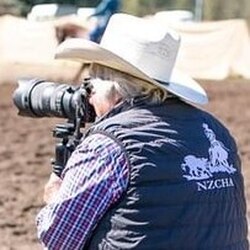
Photos on this site are credited to
HOLMES CUTTING HORSE PHOTOGRPHY
To view NZCHA photographs visit
holmescuttinghorsephotography.mypixieset.com
Also on Facebook -Holmes Cutting Horse Photography. https://www.facebook.com/profile.php?id=100063557317639
HOLMES CUTTING HORSE PHOTOGRPHY
To view NZCHA photographs visit
holmescuttinghorsephotography.mypixieset.com
Also on Facebook -Holmes Cutting Horse Photography. https://www.facebook.com/profile.php?id=100063557317639


































